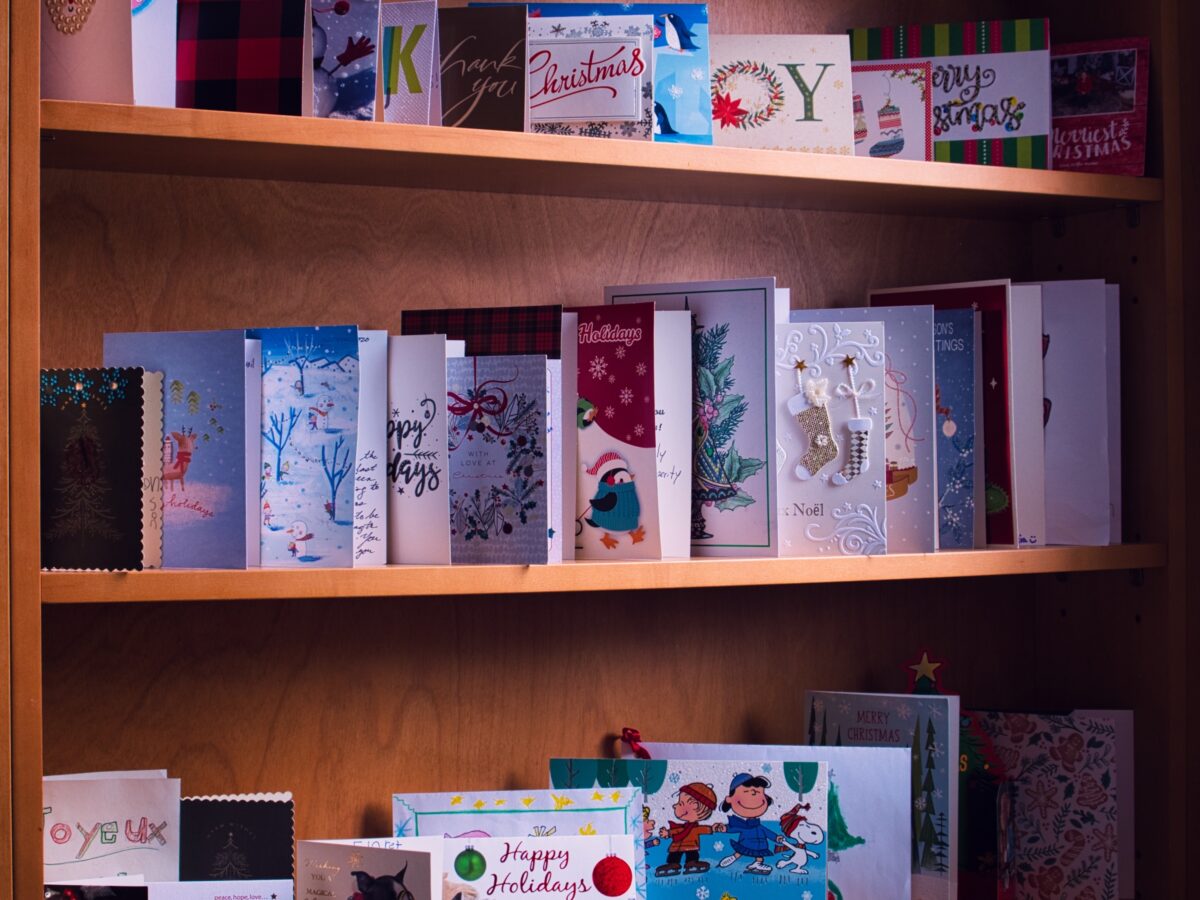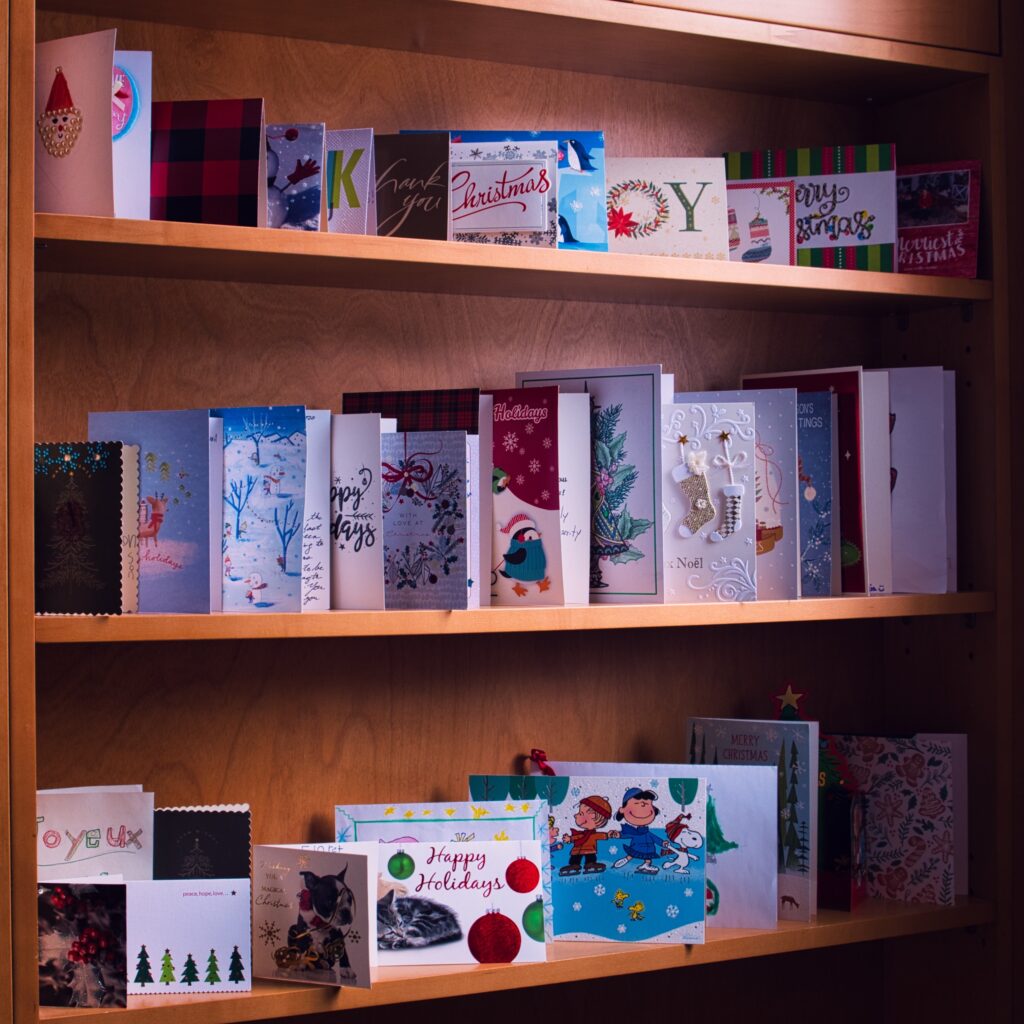Christmas cards


This weekend, I started writing my Christmas cards, an annual ritual that has been shifting ever earlier in the year as the postal service gets less reliable. It’s a tradition that has been passed down over the generations, as our families on both sides have always gone in for Christmas cards in a big way.
In the days before emails and social media, Christmas cards were the main way of keeping in touch with their network of relatives, ex-colleagues, old and new friends, that spanned many countries. Hundreds of cards were sent, to be reciprocated by a flood of similar proportions. Some contained brief, standard texts, others were filled with line upon line of close-written handwriting relating the news of the year, a few held folded up pieces of paper – the dreaded Christmas circular. After attentive reading, my family hung up the cards for display on an increasingly rickety set of plastic holders, from whence they would drift, like bloated snowflakes, keeping us children busy replacing them. Whereas my partner’s family kept them on a decorative dish on the coffee table to re-read during the holidays. The final destination of the cards also differed. I was trained from early on to spend the days before Christmas carefully snipping up the cards from the previous year to make gift tags (if you were creative you could often get quite a few out of a single card), while my partner learned to conscientiously archive them all, thrifty pragmatism versus sentimental preservation.
Under the pressure of a busy end-of-year schedule, my own Christmas card list has dwindled to a pale imitation of my parent’s. I send only a fraction of the number of cards they sent and, due to a lack of time and creative inspiration, I only write a standard message. Even so, it’s a time-consuming task. Once the box with silver stars that holds the Christmas cards has been retrieved from the loft, I sit surrounded by envelopes, stamps and address lists. As I try to keep my ink-stained fingers from smearing the cards, I note that another year of mainly typing has had a predictable effect on the quality of my handwriting, never brilliant to begin with. I can’t imagine how I ever wrote lengthy essays for school, given how my fingers cramp from writing a few words on each card.
The thought can’t help but cross my mind – isn’t this a pointless waste of time? Also of paper, and stamps, and the resources of the already overworked post-office? In an age in which I can chat live to Australia, writing a brief message on a piece of cardboard and sending it off to make its laborious and uncertain route via lorries, planes and sorting offices seems faintly ridiculous, to say the least. Each year, the number of handwritten cards we receive becomes less, as friends and family make the step to sending online greetings or, if still on paper, using a service that automatically prints and sends cards to everyone on their mailing list. Why bother actually writing the message yourself?
On the face of it, it does seem to make little difference whether the words ‘Merry Christmas and a Happy 2022!’ are written by me or printed by a computer. But there’s more to the whole process than just the outcome.
For each person, I fish around in my silver-starred box of cards, thinking of their preferences and choosing the card that best suits them – then worrying that my thoughts have followed precisely the same path as last year and I will therefore be sending them the exact same card again this Christmas. While I write the card, I think of the recipient. I smile as I remember the long-ago festive seasons spent with a childhood friend of mine, both so Christmas-obsessed that we spent the early autumn with our noses in catalogues, delighted in November in the arrival of our orders of snow spray, tinsel and cards (mostly the popular Eighties range featuring duos of improbably cuddly seals, penguins and bears), then waited in agony for the first of December so we could let loose and transform our rooms into Christmas grottos. As I write to a friend from my first job, I am transported back to the heady freedom of independence, feeling oh so grown-up as we travelled to work together, went out to restaurants and cooked each other dinners in our very own flats. While I doublecheck the correct spelling of my German penfriend’s children, I think back to the hot summer when we stopped off to see them en route to our holiday destination, and our children all played together in the blazing hot pirate playground, while we adults sat in the shade drinking cold drinks and swapping parenting stories.
The names on the card themselves, seemingly so simple and factual, in fact speak volumes. The married surnames of my friends. The new additions of babies born since last year. The gap where my divorced friend’s husband would have been, making me wonder whether this year will be the one when her Christmas card to me will bear the name of a new partner. The slight superstitious shiver as I write the names of the aging parents of my oldest friends, knowing that this might be the Christmas that my card inflicts unintended pain, if one of them has recently died. And the sadness prompted by the gaps that speak of the losses that have already happened, such as our neighbour who died between Christmas and New Year, almost one year ago now.
Even the addresses have a story to tell. As I write the address of my oldest but quite scatterbrained friend, I wonder wryly if she has perhaps once more moved without letting me know her new address (‘If you want to send me something, it’s best to check my address first’, she once airily said. ‘I move a lot’). The familiar address of my aunt fills me with sweet nostalgia, as since my father sold our childhood home, her house is the sole physical repository of my childhood memories. Stumbling over the name of my sister’s ‘new’ house, I wonder how long it will take before corona restrictions lift enough to finally allow us to see it.
My Christmas card list ranges from people I will see or talk to in the next few days, to distant friends with whom the annual card is the only point of contact. No matter which, for the brief space of time as I write the card, I am connected with them again, in a way I would never be if I simply pressed Send on an electronic message. That is why I have set a reminder in my diary for next November – ‘Buy Christmas cards’. That box with the silver stars is almost empty.